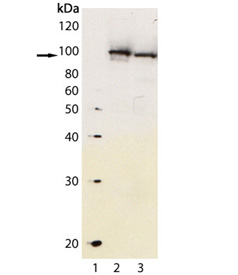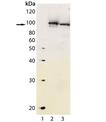Product Details
| Alternative Name: | AhR |
| |
| Host: | Rabbit |
| |
| Immunogen: | Recombinant protein corresponding to aa 1-402 of the N-terminal B-1 AhR (Aryl hydrocarbon receptor). |
| |
| UniProt ID: | P30561 |
| |
| Source: | Purified from rabbit serum. |
| |
| Species reactivity: | Mouse
|
| |
| Crossreactivity: | Does not cross-react with Arnt. |
| |
| Applications: | IP, WB
ChIP
|
| |
| Recommended Dilutions/Conditions: | Western Blot (1:2,000)
Suggested dilutions/conditions may not be available for all applications.
Optimal conditions must be determined individually for each application. |
| |
| Application Notes: | Detects a band of ~95 kDa by Western blot. |
| |
| Purity Detail: | Protein A affinity purified. |
| |
| Formulation: | Liquid. In TBS containing 0.02% sodium azide. |
| |
| Handling: | Avoid freeze/thaw cycles. After opening, prepare aliquots and store at -20°C. |
| |
| Shipping: | Dry Ice |
| |
| Long Term Storage: | -20°C |
| |
| Technical Info/Product Notes: | Cited samples:
For an overview on cited samples please click here. |
| |
| Regulatory Status: | RUO - Research Use Only |
| |

Western blot analysis of Aryl hydrocarbon receptor, pAb (Prod. No. BML-SA210): Lane 1: MW marker; Lane 2: Mouse liver extract; Lane 3: Rat liver extract.
Please mouse over
Product Literature References
Disruption of the tumor suppressor-like activity of aryl hydrocarbon receptor by arsenic in epithelial cells and human lung cancer: Y. Fu, et al.; Int. J. Biol. Sci.
19, 1983 (2023),
Abstract;
Increased sensitivity to chemically induced colitis in mice harboring a DNA-binding deficient aryl hydrocarbon receptor: K. Alvik, et al.; Toxicol. Sci.
191, 321 (2023),
Abstract;
Suppression of Ah Receptor (AhR) increases the aggressiveness of TNBC cells and 11-Cl-BBQ-activated AhR inhibits their growth: D.J. Elson, et al.; Biochem. Pharmacol. (2023),
Abstract;
Ethanolic extract of Pyrrosia lingua (Thunb.) Farw. ameliorates OVX-induced bone loss and RANKL-induced osteoclastogenesis: S.A. Jang, et al.; Biomed. Pharmacother.
147, 112640 (2022),
Abstract;
STING is an intrinsic checkpoint inhibitor that restrains the TH17 cell pathogenic program: L.E.A. Damasceno, et al.; Cell Rep.
39, 110838 (2022),
Abstract;
The cyclin-dependent kinase inhibitor p27Kip1 interacts with the aryl hydrocarbon receptor and negatively regulates its transcriptional activity: D.J. Elson, et al.; FEBS Lett.
596, 2056 (2022),
Abstract;
The gut microbial metabolite formate exacerbates colorectal cancer progression: D. Ternes, et al.; Nat. Metab.
4, 458 (2022),
Abstract;
Endogenous regulation of the Akt pathway by the aryl hydrocarbon receptor (AhR) in lung fibroblasts: F. Shi, et al.; Sci. Rep.
11, 23189 (2021),
Abstract;
Evaluation of Placentation and the Role of the Aryl Hydrocarbon Receptor Pathway in a Rat Model of Dioxin Exposure: K. Iqbal, et al.; Environ. Health Perspect.
129, 117001 (2021),
Abstract;
A genome-wide CRISPR screen identifies regulation factors of the TLR3 signalling pathway: L. Zablocki-Thomas, et al.; Innate Immun.
26, 459 (2020),
Abstract;
Full Text
Effects Of High Fat Diet And Intestinal Aryl Hydrocarbon Receptor Deletion On Colon Carcinogenesis: E.L. Garcia-Villatoro, et al.; Am. J. Physiol. Gastrointest. Liver Physiol.
318, G451 (2020),
Abstract;
Full Text
A tryptophan metabolite of the skin microbiota attenuates inflammation in patients with atopic dermatitis through the aryl hydrocarbon receptor: J. Yu, et al.; J. Allergy Clin. Immunol.
143, 2108 (2019),
Abstract;
Control of tumor-associated macrophages and T cells in glioblastoma via AHR and CD39: M.C. Takenaka, et al.; Nat. Neurosci.
22, 729 (2019),
Abstract;
Full Text
Comparison of Hepatic NRF2 and Aryl Hydrocarbon Receptor Binding in 2,3,7,8-Tetrachlorodibenzo-p-dioxin-Treated Mice Demonstrates NRF2-Independent PKM2 Induction: R. Nault, et al.; Mol. Pharmacol.
94, 876 (2018),
Abstract;
Differentiation-associated urothelial cytochrome P450 oxidoreductase predicates the xenobiotic-metabolizing activity of "luminal" muscle-invasive bladder cancers: S.C. Baker, et al.; Mol. Carcinog.
57, 606 (2018),
Abstract;
Full Text
The Environmental Sensor AHR Protects from Inflammatory Damage by Maintaining Intestinal Stem Cell Homeostasis and Barrier Integrity: A. Metidji, et al.; Immunity
49, 353 (2018),
Abstract;
Full Text
Aryl hydrocarbon receptor is required for optimal B-cell proliferation: M. Villa, et al.; EMBO J.
36, 116 (2017),
Abstract;
Microbial-Derived 1,4-Dihydroxy-2-naphthoic Acid and Related Compounds as Aryl Hydrocarbon Receptor Agonists/Antagonists: Structure-Activity Relationships and Receptor Modeling: Y. Cheng, et al.; Toxicol. Sci.
155, 458 (2017),
Abstract;
Ah Receptor Expression in Cardiomyocytes Protects Adult Female Mice from Heart Dysfunction Induced by TCDD Exposure: H. Kurita, et al.; Toxicology
355-356, 9 (2016),
Application(s): Determination of cardiac AHR expression,
Abstract;
Binding studies using Pichia pastoris expressed human aryl hydrocarbon receptor and aryl hydrocarbon receptor nuclear translocator proteins: Y. Zheng, et al.; Protein Expr. Purif.
122, 72 (2016),
Application(s): LI-COR Western analysis,
Abstract;
Genistein decreases basal hepatic cytochrome P450 1A1 protein expression and activity in Swiss Webster mice: E.B. Froyen & F.M. Steinberg; Nutr. Res.
36, 430 (2016),
Application(s): Chromatin immunoprecipitation assay,
Abstract;
Mitochondrial-targeted aryl hydrocarbon receptor and the impact of 2,3,7,8-tetrachlorodibenzo-p-dioxin on cellular respiration and the mitochondrial proteome: H.J. Hwang, et al.; Toxicol. Appl. Pharmacol.
304, 121 (2016),
Abstract;
Full Text
Type I interferons and microbial metabolites of tryptophan modulate astrocyte activity and central nervous system inflammation via the aryl hydrocarbon receptor: V. Rothhammer, et al.; Nat. Med.
22, 586 (2016),
Abstract;
Full Text
In vitro re-expression of the aryl hydrocarbon receptor (Ahr) in cultured Ahr-deficient mouse antral follicles partially restores the phenotype to that of cultured wild-type mouse follicles: A. Ziv-Gal, et al.; Toxicol. In Vitro
29, 329 (2015),
Abstract;
Aryl hydrocarbon receptor plays protective roles in ConA-induced hepatic injury by both suppressing IFN-γ expression and inducing IL-22: H. Abe, et al.; Int. Immunol.
26, 129 (2014),
Application(s): IP and WB using mouse liver homogenates,
Abstract;
Full Text
Identification of amino acid residues in the ligand-binding domain of the aryl hydrocarbon receptor causing the species-specific response to omeprazole: possible determinants for binding putative endogenous ligands: K. Shiizaki, et al.; Mol. Pharmacol.
85, 279 (2014),
Application(s): WB using cell lysates,
Abstract;
Full Text
Novel role of hnRNP-A2/B1 in modulating aryl hydrocarbon receptor ligand sensitivity: S.W. Cho, et al.; Arch. Toxicol.
89, 2027 (2014),
Abstract;
Aryl hydrocarbon receptor is a target of 17-Allylamino-17-demethoxygeldanamycin and enhances its anticancer activity in lung adenocarcinoma cells: P.H. Chen, et al.; Mol. Pharmacol.
83, 605 (2013),
Application(s): WB using human cell lysates,
Abstract;
Full Text
Aryl hydrocarbon receptor protects lung adenocarcinoma cells against cigarette sidestream smoke particulates-induced oxidative stress: Y.H. Cheng, et al.; Toxicol. Appl. Pharmacol.
259, 293 (2012),
Abstract;
Cadmium modulates expression of aryl hydrocarbon receptor-associated genes in rat uterus by interaction with the estrogen receptor: F.M. Kluxen, et al.; Arch. Toxicol.
86, 591 (2012),
Abstract;
TGF-β1 signaling plays a dominant role in the crosstalk between TGF-β1 and the aryl hydrocarbon receptor ligand in prostate epithelial cells: A. Staršíchová, et al.; Cell Signal.
24, 1665 (2012),
Abstract;
Identification of the aryl hydrocarbon receptor target gene TiPARP as a mediator of suppression of hepatic gluconeogenesis by 2,3,7,8-tetrachlorodibenzo-p-dioxin and of nicotinamide as a corrective agent for this effect: S. Diani-Moore, et al.; J. Biol. Chem.
285, 38801 (2010),
Application(s): ChIP using chick embryo hepatocyte (CEH) homogenates,
Abstract;
Full Text
General Literature References
ER alpha-AHR-ARNT protein-protein interactions mediate estradiol-dependent transrepression of dioxin-inducible gene transcription: T.V. Beischlag & G.H. Perdew; J. Biol. Chem.
280, 21607 (2005),
Abstract;
Agonist and chemopreventative ligands induce differential transcriptional cofactor recruitment by aryl hydrocarbon receptor: E.V. Hestermann & M. Brown; Mol. Cell. Biol.
23, 7920 (2003),
Abstract;
The aryl hydrocarbon receptor and aryl hydrocarbon receptor nuclear translocator protein show distinct subcellular localizations in Hepa 1c1c7 cells by immunofluorescence microscopy: R.S. Pollenz, et al.; Mol. Pharmacol.
45, 428 (1994),
Abstract;










